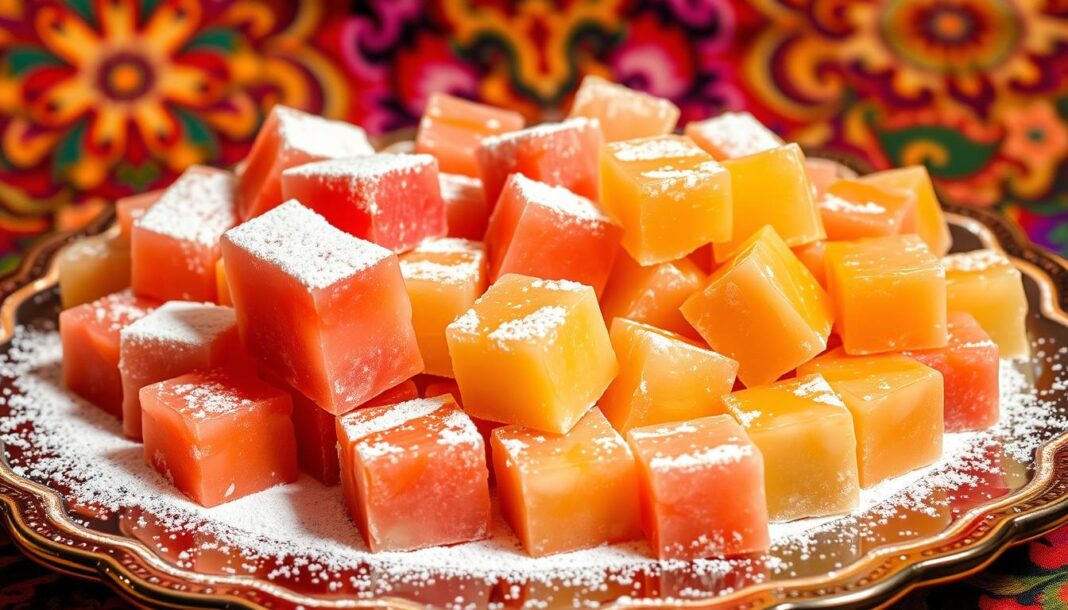We journey into the enchanting world of a confection that has captivated readers and moviegoers through C.S. Lewis’s beloved Chronicles of Narnia series. The traditional Middle Eastern candy gained worldwide recognition through its pivotal role in tempting young Edmund Pevensie in the fantasy classic.
Turkish Delight, a gummy treat that originated in Turkey, has a unique gel-like consistency and delicate flavoring that has remained largely unchanged for centuries. Made from a gel created by heating sugar and starch, it has a texture somewhere between gumdrops and Jell-O. The starch mellows out the taste, letting the citric acid and extracts shine through, creating a truly exquisite taste experience that continues to intrigue food enthusiasts today.
Key Takeaways
- Discover the historical origins of Turkish Delight and its significance in literature.
- Explore the unique taste profile and texture of this traditional candy.
- Understand the role of Turkish Delight in C.S. Lewis’s Chronicles of Narnia.
- Learn why this confection remains a beloved treat among food enthusiasts.
- Uncover the cultural significance of Turkish Delight in modern times.
The Magical Allure of Turkish Delight in Narnia
In ‘The Chronicles of Narnia,’ the magical allure of Turkish Delight serves as a powerful symbol, enticing Edmund with promises of comfort and betrayal. The White Witch’s use of this confectionery to tempt Edmund Pevensie is a pivotal moment in C.S. Lewis’s narrative, weaving a complex web of desire, loyalty, and deception.

Edmund’s Temptation in The Chronicles of Narnia
Edmund’s encounter with the White Witch in the snowy landscape of Narnia is a defining moment in the story. The psychological impact of her calculated offering reveals much about Edmund’s character—a cold, hungry boy far from home who finds comfort in the familiar sweetness of Turkish Delight. C.S. Lewis’s deliberate choice of this treat carries significant symbolic weight, representing exotic luxury that would have been particularly enticing in post-war Britain when sugar was still rationed.
- The scene highlights Edmund’s vulnerability and the White Witch’s cunning, as she uses the promise of “more Turkish Delight than you could eat” to lure him into betrayal.
- The magic of the White Witch’s offer lies in its simplicity, preying on a child’s desires while masking sinister intentions.
The White Witch’s Enchanting Offer
The White Witch’s enchanting offer is not just about the Turkish Delight itself but what it represents—a piece of a world beyond Edmund’s mundane reality, filled with magic and wonder. This moment in the book, “The Chronicles of Narnia,” has become an iconic representation of temptation, with the Turkish Delights covered in powdered sugar serving as a tangible object of desire.
By examining this pivotal scene, we gain insight into the enduring appeal of Turkish Delight as a literary symbol and its role in shaping the narrative of “The Chronicles of Narnia.”
The Rich History of Edmund’s Turkish Delight

With roots tracing back to the Ottoman Empire, Turkish Delight has become an integral part of literary history. Traditionally, Turkish delights are made from lokum, a gel-like confection created by heating sugar syrup and a cornstarch slurry mixture until thickened. This gel is then flavored, usually with rosewater, and sometimes includes add-ins like pistachios or walnuts.
Origins in Turkey and the Middle East
The authentic origins of Turkish delight, or lokum, date back to the 18th-century Ottoman Empire, where it was developed as a luxury confection in the sultan’s court. The traditional preparation methods have remained consistent over time, with the basic formula of sugar syrup and starch creating the distinctive chewy texture that defines true Turkish delight. The cultural significance of rosewater and other floral essences in Middle Eastern cuisine provides insight into why these flavors became the signature taste profile of authentic Turkish delight.
How Turkish Delight Became a Literary Icon
Turkish Delight made its way to Victorian England, where exotic foods from the Ottoman Empire became fashionable among the upper classes. C.S. Lewis’s literary choice to feature Turkish delight in The Chronicles of Narnia rather than a more common British sweet reveals his understanding of how foreign delicacies could represent both temptation and worldliness. This elevation of Turkish delight from mere candy to a powerful literary device continues to intrigue readers around the world, making it an iconic element in the book.
Creating Authentic Edmund’s Turkish Delight at Home

Making authentic Edmund’s Turkish Delight at home is a rewarding experience that requires patience and attention to detail. To create this classic confectionery treat, you’ll need to understand the traditional ingredients and preparation methods.
Traditional Ingredients and Preparation
The key to making great Turkish Delight lies in achieving the perfect balance between sugar and starch. This balance creates the distinctive texture that’s neither too firm nor too soft.
The Perfect Sugar and Starch Balance
To achieve this balance, you’ll need 4 cups of white sugar and 1 cup + 2 tablespoons of cornstarch. The sugar provides sweetness, while the cornstarch helps to create the gel-like texture. Getting the temperature just right—the soft ball sugar stage at 250°F—is crucial in making Turkish Delights.
Flavoring with Rosewater and Other Extracts
Traditional Turkish Delight is flavored with rosewater, but you can also experiment with other extracts like orange blossom water or bergamot. Add 1 teaspoon of rosewater extract or your chosen flavored extract to give your Turkish Delight a unique taste.
Step-by-Step Recipe Guide
To make Edmund’s Turkish Delight, start by creating a sugar syrup with 4 cups of white sugar and 1½ cups of water. Bring the mixture to the soft ball stage (250°F), then remove from heat. In a separate bowl, mix 1 cup + 2 tablespoons of cornstarch with 4 cups + 10 teaspoons of water to create a slurry. Gradually add the slurry to the sugar syrup, stirring constantly.
Continue cooking the mixture until it thickens, then remove from heat and add 1 teaspoon of rosewater extract or your chosen flavored extract. Pour the mixture into a greased box or mold, and let it set at room temperature for several hours.
Tips for Perfect Turkish Delight Every Time
To ensure your Turkish Delight turns out perfectly every time, be patient and don’t rush the process. Make sure to achieve the correct temperature, and don’t overmix the mixture. If you encounter any issues, refer to our troubleshooting guide for common questions and solutions.
Why Edmund’s Turkish Delight Continues to Captivate Today
As we explore the lasting impact of Edmund’s Turkish delight, it’s clear that this confection has left an indelible mark on popular culture.The Chronicles of Narniahas transformed Turkish delight from a regional specialty into a globally recognized treat, captivating generations of readers. The nostalgic connection between food and literature creates a powerful sensory experience, allowing readers to literallytastethe story and form a deeper connection to the narrative.
Today, it’s easy to find Turkish delight in a variety of flavors, from traditional rosewater to modern innovations. Whether you’re channeling your inner Edmund or simply looking for a sweet treat that feels like it’s from another world, these chewy, powderedsugar-coated gems are worth the wait. Modern confectioners have capitalized on the literary fame of Turkish delight, creating special “Edmund’s” branded versions and Narnia-themed packaging that appeals to fans of the books and films.
The cultural impact of Turkish delight extends beyond merecandyconsumption; it has become a metaphor in modern discourse for temptation and indulgence. For many fans, the experience of tasting Turkish delight for the first time creates a tangible connection to a beloved childhood story, bridging the gap between fiction and reality in a uniquely delicious way. As we reflect on the significance of Edmund’s Turkish delight, it’s evident that its allure will continue to captivate audiencestodayand for generations to come.


